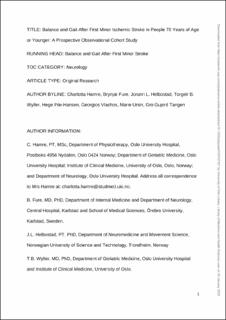| dc.description.abstract | BACKGROUND: Two-thirds of patients with stroke experience only mild impairments in the acute phase, and the proportion of patients <70 years is increasing. Knowledge about balance and gait and predictive factors are scarce for this group. OBJECTIVE: The objective of this study was to explore balance and gait in the acute phase and after 3 and 12 months in patients <=70 years with minor ischemic stroke (National Institutes of Health Stroke Scale score <=3). This study also explored factors predicting impaired balance after 12 months. DESIGN: This study was designed as an explorative longitudinal cohort study. METHODS: Patients were recruited consecutively from 2 stroke units. Balance and gait were assessed with the Mini-Balance Evaluation Systems Test (Mini-BESTest), Timed Up and Go, and preferred gait speed. Predictors for impaired balance were explored using logistic regression. RESULTS: This study included 101 patients. Mean (SD) age was 55.5 (11.4) years, 20% were female, and mean (SD) National Institutes of Health Stroke Scale score was 0.6 (0.9) points. The Mini-BESTest, gait speed, and Timed Up and Go improved significantly from the acute phase to 3 months, and gait speed also improved from 3 to 12 months. At 12 months, 26% had balance impairments and 33% walked slower than 1.0 m/s. Poor balance in the acute phase (odds ratio = 0.92, 95% confidence interval = 0.85-0.95) was the only predictor of balance impairments (Mini-BESTest score <=22) at 12 months poststroke. LIMITATIONS: Limitations include lack of information about pre-stroke balance and gait impairment and poststroke exercise. Few women limited the generalizability. CONCLUSION: This study observed improvements in both balance and gait during the follow-up; still, about one-third had balance or gait impairments at 12 months poststroke. Balance in the acute phase predicted impaired balance at 12 months. | en_US |
